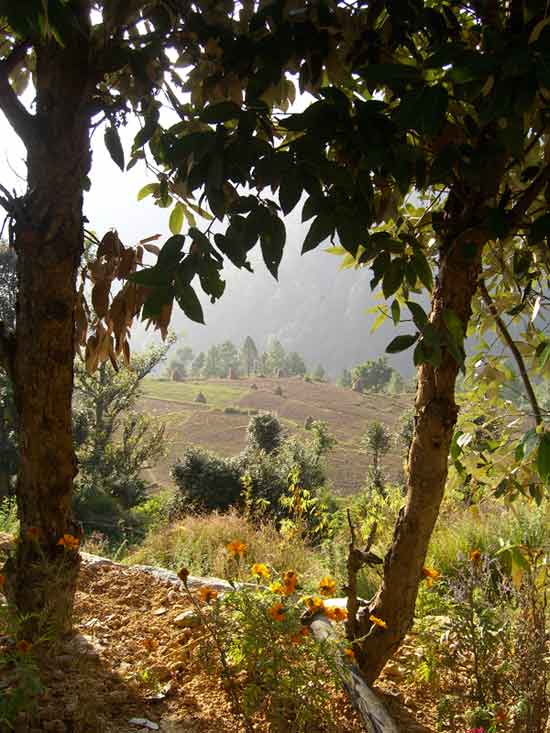|
|
Village Ways – freefrom in the Himalayas |
|
Michelle Berriedale-Johnson goes walking in the foothills of the Himalayas
What do you do?’ asked my two young Kumaon guides.
All walking parties are accompanied by two local guides; mine were 22-year-old Hem (with goat) and 30-year-old Raju (below with 99-year-old granny!). All Village Ways guides speak very serviceable English and have had two months’ intensive training, which includes fairly detailed knowledge of the local flora and fauna. Between them Hem and Raju could not have taken more care of my safety or my comfort. Always around to see that I had everything that I wanted but never intrusive and they had mountain peoples’ gift of companionable silence without the need for endless chat.
The walking The Binsar Sanctuary (in the far north-eastern corner of India, nestling between Tibet and Nepal) is a mixture of pine forest, Himalayan oak and rhododendron – a forest of red blossom in March and April. There is only one road, access to the villages being along ancient forest paths. These can be steep or gentle, narrow or wide but would present no problem to anyone who had walked in the Lake or Peak districts of England. The distances between villages vary from two to five hours walking but the pace is gentle with many stops for rests, water and whatever snacks you have squeezed into your pack. Khali to Dalar My first night’s stop was at Hem’s home village, Dalar. An hour’s walk brought us to the bottom of the valley where terraced slopes were being ploughed for the winter wheat sowing. Small bulls pulled ancient wooden ploughs guided by the farmer, followed by women with mallets breaking up the larger clods: hard labour under the hot Himalayan sun. Dalar is perched on the side of the hill and, like all the Binsar villages, has already lost about half of its population. The houses are strung out along the mountainside and the first that we came to was Hem’s (below), where his father drying soya beans and chillis on the terrace.
As with all the village houses, Hem’s house is surrounded by a verdant vegetable garden bulging with cabbages, onions, garlic, coco yams, mustard greens, pumpkins, ginger, coriander and much more. In between the vegetables grow roses, canna lilies, chrysanthemum, daisies, zinnias, drooping amaranth and hundreds of marigolds. And over all arch walnut trees, apple trees, peach, pear, apricot, fig and heavily laden lime trees. The soil is fertile and water from the mountains is plentiful so most villages are largely self- sufficient – which is just as well as a visit to the market can involve a three-hour walk to the nearest road, two hours on a bus, then a three-hour walk home, carrying your purchases! Darkness comes early in the Kumaon and since light is scarce and the work is hard the locals retire to bed – and the light supply retires with them. Not that turning in early is any hardship. The beds are very comfortable and there is charm in gazing up, by the light of your candle, at the pine beams and slats of the roof or out the open shutters at the thousands of brilliant stars which crowd the sky.
Day two was a relatively short, but delightful, walk to Risal (the only village in a valley) through mixed pine, oak and rhododendrons following the paths of several streams now reduced to a lush but manageable post- monsoon flow. A lazy afternoon in the sun was divided between a book and exploring Risal where the late afternoon light was gentle and small blue and white houses with rows of pumpkins drying on their stone roofs, nestled into the hillside above. To Satri The following morning a steepish climb
Satri is the smallest village in the Village Ways group, perched on a spectacular ridge and now only consisting of three families, including six bubbly teenage girls. After dinner all the villagers, including the girls, a bongo drum and set of castanets, gathered in the guest house to sing and dance, only interrupted by the constant ringing of the girls’ mobile phones! Satri to Gonap From Satri to Gonap, village number four, we left the pine forest (and the endless and deafening crickets) and traversed two valleys of oak, mixed forest – and birds: endless varieties of woodpecker, jays, tree pyes, parakeets, rose finches, grey bustards, sparrows, swallows, bullbulls and many more.
The evening village walk in Gonap extended as far as the ‘cricket pitch’ at the far end of the fields – a small clearing where three sticks and a cloth ball were providing the boys of the village with an enjoyable if somewhat erratic game of cricket. Zero Point & Kathdhara The walk to the last village, Kathdhara, was via Zero Point, the highest point in Binsar. As we rounded a bend in the path, the high Himalayan peaks floated into view, detached from the green mountains below by a thick haze, almost indistinguishable from the sky above.
Kathdhara is the biggest of the villages – over 100 inhabitants – and the one which sits least comfortably within the Village Ways concept. The most obviously grating note is the sparkling new electricity supply which marches through the village – but is not connected. Connection was scheduled for 1998, the year that the mains-electricity-free sanctuary was created. The guest house terrace in Kathdhara looks over the valley where, the following morning, a dead oak tree was full of black- faced monkeys taking their morning sun bath. The monkeys are such a problem that, during daylight hours shifts of villagers armed with sticks, stones and loud voices, mount guard where the terraces meet the forest to try, not always successfully, to drive the monkeys off.
Some of the younger women were Although Kathdhara still has over 100 inhabitants, including a number of retired soldiers and a very jolly retired Delhi policeman, there was no shortage of empty houses. And one can understand why. Life is hard work in the mountains and the lure of the city is strong. But for everyone who wants to leave, there is one, like Hem or Raju, who loves their mountains, their measured, sun-regulated way of life, their buffalo and goats, their fresh vegetables and blooming marigolds and for whom the noise, dirt and bustle of the city holds no charm. For them Village Ways has provided a lifeline. For the visitor, refreshed in mind and body by the mountains, and returned, with charm and efficiency, to Delhi and the plane home, Village Ways provides a wonderful, invigorating, yet relaxing holiday! Essential Contacts / Information Village Ways - for all holidays costs etc. Jet Airways - cheap direct flights to Delhi Delhi - Lutyens Bungalow Comfortable boots - mine were Brasher lightweight leather First published in 2007 June 2012 – Editor: Since this article was published five years ago, Village Ways have spread their wings and now can offer not only the original walking holidays in the Binsar Sanctuary but similar holidays further up the Himalayas, in Kerala (south India), Rajashthan and the Thar Desert and, even further afield in Ethiopia. See their site at www.villageways.com, for full details and/or sign up to their newsletter.
|

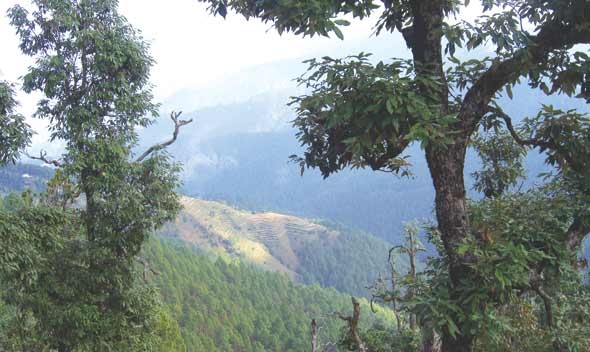

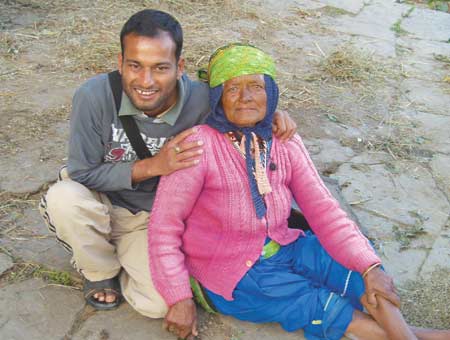

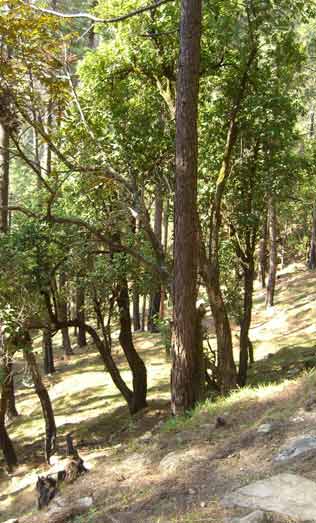 Risal
Risal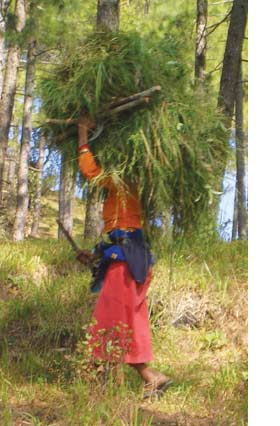 What, however, was somewhat disconcerting,
What, however, was somewhat disconcerting,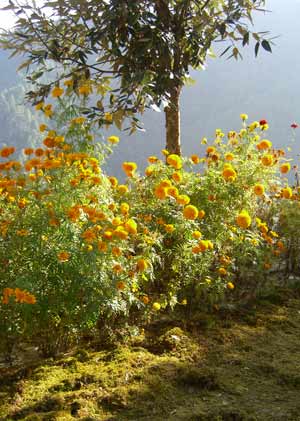 Gonap nestles into the hillside below its peak and its guest house is in the charge of green- fingered Mr Singh who has surrounded it with a butterfly-filled marigold garden and carpeted the ground with a velvet soft moss lawn – a delight to walk on when making a torch-lit visit to the loo in the night!
Gonap nestles into the hillside below its peak and its guest house is in the charge of green- fingered Mr Singh who has surrounded it with a butterfly-filled marigold garden and carpeted the ground with a velvet soft moss lawn – a delight to walk on when making a torch-lit visit to the loo in the night!
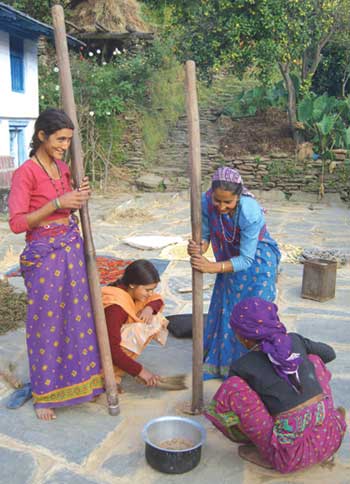 Because Kathdara is such a big village
Because Kathdara is such a big village